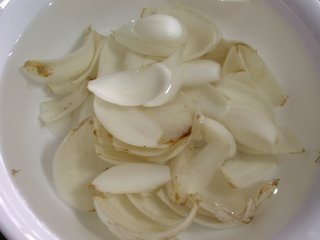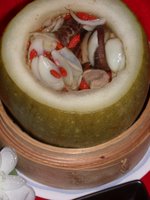WARNING: LOOOONG POST AHEAD

After the storm, comes the calm. Singapore weather is always unpredictable. The sun is either piercingly hot or the skies, water-logged and sulky. Coupled with the island’s perpetually intense humidity, you could not find a better hotbed for the flu.
Like many others, I’ve been trying to keep the flu at bay all week. After a particular hard night, I decided it is definitely time for some good, old-fashion Chinese medicinal soups.
My fascination with the lotus plant is fairly obvious. I’ve written about the seeds, flower and root and finally, it is time for the leaves. Featuring the lotus leaf or he ye for Weekend Herb Blogging is rather apropos after the heightened emotions of this week - lotus in Mandarin is he, which sounds like the word for harmony or peace.
Lotus Leaf aka He Ye
The summer I was eight and visiting my grandfather, I witnessed my now-uncle’s diabolically successful courtship of my youngest aunt, the undisputed raving beauty (and lunatic, in my opinion) of the family. By all accounts, my uncle would never have fitted in our family. Poorly uneducated with a blue collar job, his greatest disadvantage in wooing Aunt Kris was that he was Chinese. The first time he shadowed her from school, the other aunts immediately dismissed him as a non-contender. After all, how could he even communicate with her?
But Uncle Francis was a wily bugger. He watched. He plotted. He spoke hardly any English at all. But he spoke FOOD. His visits always heralded the most amazing aromas and beguilingly bulbous bags of mouth-watering bribes. He silenced the covey of Valkyries with sweet delights. My grandfather received wines and rich, unctuous roasts. He remembered each person’s likes and dislikes and bribed us according to our individual Achilles heel.
And he targeted a skinny, little eight-year-old as his spy.
To Uncle Francis’ credit, he never exposed me as the Deep Throat of his courtshipgate. Even after he’d won the lady fair, he still had time for me. My love for Chinese kungfu comics began in our garden as he painstakingly explained the storylines in very broken English. He introduced me to simple, home-cooked Chinese cuisine that was as wildly exotic to me as reindeer stew or miso soup!
In exchange, I divulged Aunt Kris’ daily schedule, gave early warnings of competition and coached him on each family member’s likes and idiosyncrasies. His visits were eagerly awaited just for the gastronomical treats! And it was fun to watch the family’s befuddled reaction to this indomitable, unfazeably good natured and unsuitable man.
On one of his visits, he lifted a plump, leaf-wrapped bundle from an acid green plastic bag that pummeled my olfactory senses with the earthy yet fresh scent of tea.
I eyed him covetously as he cut through dark twine and languorously peeled away layers of dull green leaves to unveil a fragrant mound of glutinous rice with glistening mushrooms, lotus seeds, Chinese sausages and other delectable morsels. My attention, however, was totally focused on the leaf! Pressing my nose to it, I inhaled deeply to fully absorb and separate the different nuances. I rubbed, fondled and bent the leaf to gauge its elasticity. I chewed on a little corner to test its texture and taste.
 Running to my grandfather, I demanded an answer to this verdant puzzle with such petulant frustration that he told me that to learn what the leaf was, I first had to learn to be like the leaf. I wondered if he’d been spiking his shisha with something more than tobacco and when I had changed my name to Grasshopper.
Running to my grandfather, I demanded an answer to this verdant puzzle with such petulant frustration that he told me that to learn what the leaf was, I first had to learn to be like the leaf. I wondered if he’d been spiking his shisha with something more than tobacco and when I had changed my name to Grasshopper.
Grandfather explained that the lotus leaf, by virtue of its name, he ye, was prized as a symbol of harmony and peace. Oh, right … OMMM then. Now tell me what it does! Turns out the lotus leaf regulates the vital functions of the heart and has the ability to quench thirst, correct frequent passing of dark urine (a sure sign of over-heatiness and that you’ve been eating some funky, dark foods), and stop diarrhoea.
The lotus leaf is sweet in taste with a hint of bitterness – isn’t that the case with most things in life? It is considered a neutral herb in Chinese medicine, with the ability to clear summer heat, to the extent of alleviating fevers, and aid digestion. It has wonderful curative properties as it can heal bruises, reduce muscle spasms and stop bleeding. Believed to cure symptoms of dampness due to heat or wind, it explains why the lotus leaf is so useful in easing dizziness and nausea.
When purchasing lotus leaves, try to obtain dark, dry leaves without mould or insect bites. The best place to get these would be the Chinese medical halls. The leaves sold in the medical halls are usually dried but some Asian stores will sell fresh lotus leaves whole. Do not be surprised if these turn out to be rather massive – they can grow up to about 18 inches.
Lotus leaves are widely used in Chinese medicine as well as daily culinary pursuits. From lining bamboo steamers for steam fish or meats to fortifying tonics, this catalyst of health and harmony is indispensable in today’s recipe.
Lily Bulb aka Bai He
As a child, dried lily bulbs were the play toys that kept me out of my grandfather’s hair as he inventorised his herbs or consulted his books. That early memory stuck and I grew up with the childlike naiveté that lily bulbs emerged from the earth as dried, pale brown petals.
 Stumbling upon a trowel of fresh lily bulbs in the local supermarket, I initially assumed that these were a misplaced carton from the gardening department. Then it struck me that you could actually eat these! Feeling extremely foolish, I tried to redeem myself by doing some research on this herb.
Stumbling upon a trowel of fresh lily bulbs in the local supermarket, I initially assumed that these were a misplaced carton from the gardening department. Then it struck me that you could actually eat these! Feeling extremely foolish, I tried to redeem myself by doing some research on this herb.
The lily bulb is called bai he in Mandarin – another symbolic name. Again, the he refers to harmony and peace except in this case, it is increased a hundredfold with the bai prefix.
Like the lotus leaf, the lily bulb is also sweet in taste with an underlying bitterness. A cooling herb, it nourishes the yin, moistens the lungs and has a calming effect. It is highly beneficial for people with weak yin qi and latent heat. Lily bulbs are excellent for easing insomnia, restlessness and irritability.
One of the best cures for a persistent cough or sore throat is a soup made of lily bulbs and mung beans. I hated that soup as a child and would sneak it to the dogs instead. The lily bulb is brilliant for detoxifying. It promotes urination and halts bleeding by cooling the blood and strengthening the spleen and stomach. What I find truly wondrous about this plant is that it is apparently used to cure tuberculosis.
Fresh lily bulbs are usually magnolia in colour but the dried versions range from beige to slightly purplish. You know a lily bulb of quality from its fleshy, thick and brittle petals that are devoid of unpleasant odours and are only mildly bitter in taste.
Wintermelon aka Dong Gua
 The wintermelon looks uncannily like a watermelon as first glance. However, the flesh of the wintermelon is the complete opposite being an opaque vanilla instead of lurid red.
The wintermelon looks uncannily like a watermelon as first glance. However, the flesh of the wintermelon is the complete opposite being an opaque vanilla instead of lurid red.
I love the clean, mellow taste of this melon but never knew that it aids in weight loss. No, not by tossing it around and staggering under its weight while doing cross training! The ancient Chinese considered this a dietary “herb” due to its high vitamin B and dietary fibre content.
WIntermelons are sweet in taste and cool by nature. They clear heat, promote urination, expel phlegm, help eliminate pus and can cure constipation. Eating wintermelons can help clear the dampness arising from heatiness. They are also a good cure for coughs and intestinal pains as they lubricate the intestines very effectively.
The seeds and peel of the wintermelon are used as much as the flesh. While the seeds intensify the properties of the wintermelon as long as they are not toasted, the peel has the ability to lessen swelling and quench thirst. Wintermelons alleviate abdominal flatulence and urinary problems and have so many benefits that Chinese physicians are prone to recommend it to patients suffering from hypertension and diabetes.
I once asked why wintermelons were thus named when you can get them almost all year round. Ironically, the answer was that they are actually grown in summer and autumn but were traditionally kept in store till winter, hence their name. It makes sense in a crazy kind of way.
These three ingredients are the key players in a soup I morphed from two recipes. The foundation recipe was Lotus Leaf and Pork Soup, a lung nourishing tonic that is low in cholesterol and calories. The soup promotes weight loss without adversely affecting the gastrointestinal system – which I think is very important. Not that I need to lose any weight but I wanted to try this out to see if it works. I am my own Frankenstein and it gives me an excuse to pig out to balance it out.
Then I came across another recipe on Good Bites for a wintermelon soup that also aids weight loss and detoxification. I decided to combine the two by using all the core ingredients of the Lotus Leaf and Pork Soup but cooking and serving it in a whole wintermelon.
Lotus Leaf and Pork Soup in Steamed Wintermelon
 5 conpoys aka dried scallops
5 conpoys aka dried scallops
- soaked in water for about 2 hours to soften
5 dried shiitake mushrooms
- soaked in water for about 30-45 minutes to soften and stalks trimmed
300g lean pork, cubed
10g lotus leaves aka he ye
2 fresh lily bulbs aka bai he
 1 ½ tbsp wolfberries aka gou qi
1 ½ tbsp wolfberries aka gou qi
1 whole wintermelon
- mine was about 1 kg heavy and barely 6 inches in diameter
1 chicken stock cube
Salt
Special equipment: Bamboo steamer but you can use any deep steamer
 1. Pack the lotus leaves into a muslin sachet (you can get these from the Chinese medical halls when you buy your herbs)
1. Pack the lotus leaves into a muslin sachet (you can get these from the Chinese medical halls when you buy your herbs)
 2. Blanch the pork cubes in hot, boiling water. Remove and rinse with cold water. Drain.
2. Blanch the pork cubes in hot, boiling water. Remove and rinse with cold water. Drain.
 3. Put the pork cubes into a claypot or earthernware pot with 5 cups of water, the lotus leaves sachet, the stock cube, the conpoy and mushrooms and bring to boil
3. Put the pork cubes into a claypot or earthernware pot with 5 cups of water, the lotus leaves sachet, the stock cube, the conpoy and mushrooms and bring to boil
4. Lower the heat and simmer on very low flame for about 1 hour
 5. In the meantime, slice off the woody root of the lily bulb, peel off the petals and clean. Set aside.
5. In the meantime, slice off the woody root of the lily bulb, peel off the petals and clean. Set aside.
 6. Slice off the top of the wintermelon and dig out the seeds with a spoon, leaving a hollow in the middle. Do not dig out all the flesh nor dig too deep down – just get rid of the seeds. Dig out the seeds from the wintermelon cap too. It's messy work but strangely gratifying.
6. Slice off the top of the wintermelon and dig out the seeds with a spoon, leaving a hollow in the middle. Do not dig out all the flesh nor dig too deep down – just get rid of the seeds. Dig out the seeds from the wintermelon cap too. It's messy work but strangely gratifying.
7. Add the wolfberries to the soup and continue cooking for about 15-20 minutes 

8. Place the wintermelon onto the bamboo steamer and stack it in a pot deep enough to cover the entire melon and wide enough to stick your hands in their later to remove the steamer without screaming the house down in pain.
9. Pour enough water into the pot to touch the bottom slats of the steamer
 10. Ladle the soup into the hollow in the wintermelon, leaving about ¼ inch space from the top. Keep the remaining soup warm on the side.
10. Ladle the soup into the hollow in the wintermelon, leaving about ¼ inch space from the top. Keep the remaining soup warm on the side.
11. Cover with the wintermelon cap and cover the pot to steam on very low heat for about 2 hours, remembering to replenish the water each time it begins to dry out
12. Uncover the wintermelon, add the lily bulbs and season with salt to taste. If you need more liquid, add the remaining soup
13. Replace the wintermelon cap and continue to simmer for 15 minutes
13. Turn off the heat and carefully remove the entire steamer from the pot. You may be brave and transfer the melon onto a platter to serve but my wintermelon was so soft and tender that I did not dare risk it.
14. Serve hot
 As I sipped the fragrant broth, I was impressed at how easy it was to make this soup. The most complicated part was the wintermelon and even that was more a case of elbow grease than skill.
As I sipped the fragrant broth, I was impressed at how easy it was to make this soup. The most complicated part was the wintermelon and even that was more a case of elbow grease than skill.
The perfumed broth was a pleasant surprise with its restrained hint of herbs that did not overpower the palate. The meaty, succulent mushrooms and the flavourful conpoy sweetened the soap wonderfully while accentuating the lotus leaves and lily bulbs. I think this is a well harmonised dish that allows each ingredient to make a coy introduction to the tastebuds with each bite. I must admit I did not expect it to be so tasty. For once, a spoonful of soup makes the medicine go down.
The only disappointment was in the seasoning and that was entirely my oversight. I'd expected the chicken stock cube to provide enough salt and so only added about a teaspoon of salt to the soup. It tasted just right before I ladled it into the wintermelon but I reckoned without the faintly tart and absorbent flesh of the wintermelon negating all the saltiness of the broth. The end result was anything but bland but I still felt it could have been a smidgeon saltier. Next time I will be a little heavier handed with the salt. And if I had time, I would make the chicken stock from scratch.
 Perhaps it is a psychological effect from knowing that this soup is a health tonic, but I felt really good after dinner. I had wisely refrained from adding anything else to the meal. No rice. No side dishes. Just the soup. But it was such a tasty dish that before I knew it, I was literally scrapping bottom.
Perhaps it is a psychological effect from knowing that this soup is a health tonic, but I felt really good after dinner. I had wisely refrained from adding anything else to the meal. No rice. No side dishes. Just the soup. But it was such a tasty dish that before I knew it, I was literally scrapping bottom.
Taste wise I give this soup an 8.5/10 because it tasted really good and I loved the presentation of the wintermelon “cauldron”. Health wise I think this deserves a 10/10.
There is one major drawback to this recipe. You can’t have a chocolate for dessert after this. The recipe counsels against any high-calorie intake when taking this soup. I’m not sure if that’s a proper health warning or just common sense but I headed for my oranges instead.





Categories - In Hot Soup, Meat Me for Dinner, VeggieMight, Chinese Herbs







 3. Line the bottom of the pie tin with the cracker & butter crumbs. Preheat the oven to 200 deg Celsius.
3. Line the bottom of the pie tin with the cracker & butter crumbs. Preheat the oven to 200 deg Celsius. 9. Remove the seafood mixture from the stove and stir in the egg mixture
9. Remove the seafood mixture from the stove and stir in the egg mixture

 11. Pour into the prepared pie tin and sprinkle the grated Parmesan to cover and dot with butter
11. Pour into the prepared pie tin and sprinkle the grated Parmesan to cover and dot with butter










 - 3-4 shallots, cut in half
- 3-4 shallots, cut in half  7. Add the shallot and sauté gently till soft and transparent
7. Add the shallot and sauté gently till soft and transparent 8. Add the enoki mushrooms and peppercorns and sauté gently for about 1-2 minutes
8. Add the enoki mushrooms and peppercorns and sauté gently for about 1-2 minutes 10. Pour in the cream and turn up the heat a little to simmer and reduce the sauce till well mixed and thickened
10. Pour in the cream and turn up the heat a little to simmer and reduce the sauce till well mixed and thickened 13. Mound the Sweet Leeks on a corner of your platter and place the salmon over it, centering the fish
13. Mound the Sweet Leeks on a corner of your platter and place the salmon over it, centering the fish 2 stalks of leeks, trimmed, cleaned and chopped
2 stalks of leeks, trimmed, cleaned and chopped 1. Heat the butter and oil and add the garlic and leeks and sauté till soft and fragrant
1. Heat the butter and oil and add the garlic and leeks and sauté till soft and fragrant





 2. Spread the cream cheese onto the cut sides of the bun
2. Spread the cream cheese onto the cut sides of the bun  3. Sprinkle the chocolate drops on the bottom half of the bun
3. Sprinkle the chocolate drops on the bottom half of the bun 4. Slice the bananas and lay them on top of the chocolate drops
4. Slice the bananas and lay them on top of the chocolate drops  5. Sprinkle a little more chocolate drops on top
5. Sprinkle a little more chocolate drops on top 7. Zap in the microwave for about 45 seconds to melt the chocolate
7. Zap in the microwave for about 45 seconds to melt the chocolate




 5 conpoys aka dried scallops
5 conpoys aka dried scallops 1 ½ tbsp wolfberries aka gou qi
1 ½ tbsp wolfberries aka gou qi 1. Pack the lotus leaves into a muslin sachet (you can get these from the Chinese medical halls when you buy your herbs)
1. Pack the lotus leaves into a muslin sachet (you can get these from the Chinese medical halls when you buy your herbs) 2. Blanch the pork cubes in hot, boiling water. Remove and rinse with cold water. Drain.
2. Blanch the pork cubes in hot, boiling water. Remove and rinse with cold water. Drain.  3. Put the pork cubes into a claypot or earthernware pot with 5 cups of water, the lotus leaves sachet, the stock cube, the conpoy and mushrooms and bring to boil
3. Put the pork cubes into a claypot or earthernware pot with 5 cups of water, the lotus leaves sachet, the stock cube, the conpoy and mushrooms and bring to boil 5. In the meantime, slice off the woody root of the lily bulb, peel off the petals and clean. Set aside.
5. In the meantime, slice off the woody root of the lily bulb, peel off the petals and clean. Set aside.  6. Slice off the top of the wintermelon and dig out the seeds with a spoon, leaving a hollow in the middle. Do not dig out all the flesh nor dig too deep down – just get rid of the seeds. Dig out the seeds from the wintermelon cap too. It's messy work but strangely gratifying.
6. Slice off the top of the wintermelon and dig out the seeds with a spoon, leaving a hollow in the middle. Do not dig out all the flesh nor dig too deep down – just get rid of the seeds. Dig out the seeds from the wintermelon cap too. It's messy work but strangely gratifying.

 10. Ladle the soup into the hollow in the wintermelon, leaving about ¼ inch space from the top. Keep the remaining soup warm on the side.
10. Ladle the soup into the hollow in the wintermelon, leaving about ¼ inch space from the top. Keep the remaining soup warm on the side.





